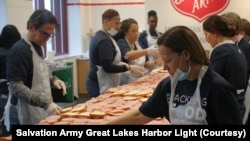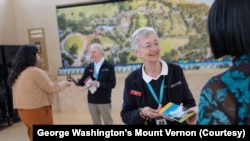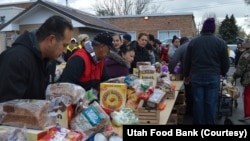Volunteerism has long been a hallmark of American democracy, culture and civic life — going back to the founding of the United States.
The first volunteer firehouse began in 1736. And in the 1800s, volunteerism in social reforms, including women's rights, child labor and the abolition of slavery, led to institutions and social services to improve the lives of others.
Today volunteerism in the U.S. is considered more important than ever.
"Civic volunteerism is a very resilient concept in the United States," said Robert Ashcraft, executive director at the Lodestar Center for Philanthropy & Nonprofit Innovation at Arizona State University.
Community connection
The Bureau of Labor Statistics noted volunteerism peaked between 2003 and 2005, when 28.8 percent of Americans said they had volunteered the previous year.
"Volunteerism is a direct indicator of people feeling connected to their communities," said Stephen Goldsmith, director of the innovations in American government program at Harvard's Kennedy School of Government. "They volunteer because they see it as an important way to help their fellow Americans."
Traditionally, volunteering involves providing regular hours to a service agency, such as a food pantry, homeless organization or children's advocacy group. But today the role of volunteering has widened to include everything from helping out at a community festival to participating in a race for a good cause.
The outcome is that formal participation in traditional volunteering has been steadily dropping as more people opt for sporadic opportunities that fit better into their lives.
Experts on volunteerism say that continues to grow.
According to a recent survey by the U.S. Census Bureau and AmeriCorps (the federal agency for national service and volunteerism), formal volunteer participation was 23.2%, a drop of 7 percentage points between 2019 and 2021. That's the biggest decline since the survey began in 2002.
"It's not a surprise," because the coronavirus pandemic was at its worst in the United States, said Ashcraft of the Lodestar Center. "I think the numbers reflect that."
Ram A. Cnaan, the director of the program for religion and social policy research at the University of Pennsylvania's school of social policy & practice, said many people cannot do traditional volunteering.
"Job demands are greater, and people are working multiple jobs," he said, and they want volunteerism that fits in their busy schedule.
"Volunteerism and the economy are very connected," said Rachel Currie-Triska, chief executive officer for Volunteer Now in Dallas, Texas, that recruits volunteers for nonprofit organizations in north Texas.
"If you look at trends when volunteerism has dipped, you'll see a downturn in more turbulent years," she said.
Help hard to come by
The CASA/GAL Association for Children, a national nonprofit serving abused and neglected children has been having trouble getting enough volunteers.
"We lost about 15% of our volunteers as people have looked to readjust their lives post-COVID," said Sarah Mackey, the chief network development officer. "However, we found that by using online training, we've been able to increase the number of volunteers."
The CASA chapter in Lexington, Kentucky was frustrated with the lack of response when they reached out to the community.
"People would express interest, but then not return emails or phone calls, or complete the training. We had not had that experience before," said Melynda Jamison, the executive director.
So, a community engagement coordinator was hired to recruit volunteers.
"We reached out to people by going to festivals, events and farmers markets and I do a lot of speaking engagements," Jamison said. "We've now been able to slightly increase the number of volunteers and our retention rate is over 90%."
While many organizations report a decline in formal volunteerism, others say they haven't noticed much change.
"We are not experiencing a shortage of volunteers," said Ginette Bott, president and CEO of the Utah Food Bank in Salt Lake. "We have a lot of corporate and school groups that volunteer for a few hours every month."
According to the latest U.S. Census/AmeriCorps survey, Utah saw an 8.8 percentage-point drop, but still has the highest rate of volunteerism in the country. Bott said having many diverse, faith-based organizations in the state has had a huge impact. "There's a definite connection between faith-based volunteerism in places like our food bank."
In Detroit, Michigan, Jamie Winkler, an executive director with the Salvation Army, said volunteers are coming in to help make and distribute food.
"Even though there's been a problem getting people to volunteer in the last year or so, we're seeing larger groups like corporations and school volunteers, that are coming sporadically, to help feed the homeless and families that are struggling," said Winkler.
Amber Murfeld, 32, said she volunteers occasionally at the food pantry at United Community, a nonprofit in Alexandria, Virginia.
"I used to volunteer regularly since it is close to my home," she said, "but I got out of the habit during the pandemic and afterwards started filling my life with other activities."
Ashcraft said while formal volunteering may decline, sporadic volunteering will continue to grow.
"Nonprofits will need to adapt to this," he said, "especially if they want to bring in young people who want to contribute but not through traditional means." He added, "with their optimism and energy, young people will also want to bring their ideas to volunteerism, whether it involves climate change, education, the arts and culture."










